Publishing a book is a drawn out and often frustrating process even on top of researching and assembling the actual draft text and graphics material. This is especially so when the cards are stacked against it because the book focuses on such a niche topic. I can tell you that the passion for sharing the material I’ve researched and assembled hasn’t diminished a bit since I started this project more than three years ago. I do want to get the back stories of the Second World War Bell Feature artists and the images of some of the original art pages they created into an attractive, hard copy form that those who would find it interesting enough to purchase could hold in their hands and proudly park on their bookshelves.
I want to take the opportunity of this column to share current progress and to solicit any suggestions, advice, or opinions that you readers would be kind enough to offer.
No contract has been signed with Chapterhouse yet but ongoing talks with them have been positive. Chapterhouse is very interested in publishing this book with the aid of a Kickstarter and they appear to be even more interested in a follow-up Gerber style book covering all of the Canadian war-time comics. Chapterhouse wants to take a bit of a different direction from my original vision of the book by wanting the Kickstarter to be focused on printing a large number of soft cover copies and printing the deluxe hard copies only if a stretch goal is reached on top of the first goal for the soft cover copies. Their idea seems to try to get a number of copies into libraries, schools, and brick and mortar book stores so that the book would have a broader national footprint right away. My intention has always been to have the Kickstarter based on reaching a fundraising goal that would first account for a quality hard cover copy for each supporter and have a couple of creative stretch goal on top of that. I’ve always felt that the production of any softcover copies for libraries, etc., could come in the form of a second edition completely separate from this original Kickstarter. I see this first Kickstarter as having the responsibility of getting a quality copy into the hands of those people who really want it (like the readers of this column, collectors of these old Canadian comics, and the family members of those individuals I have written about). Whether that produces 100 or 500 supporters, it justifies the enterprise and my effort. This first edition should be a limited quality edition that satisfies those people most interested in it. In order to see that this happens, It may very well end up that I take on this Kickstarter myself, which is something I originally didn’t want to do. So there’s still a bit of negotiation and arguing my position to go on with Chapterhouse. One way or another, a Kickstarter for the book will be launched by the end of June.
Gerald Lazare has agreed to sign a number of copies as has Jack Tremblay, but he is in Montreal and will be more difficult to get to. I think we should offer between 50 and 100 signed copies and at a higher premium than the other copies. I also think that the hardback should be produced without a dust jacket which always seems to get in the way and is the first thing to tear or crumple. I think that we should also try to do a slip case for a limited number of copies.
I have brought Dundas designer John Farr on board to design the book and work has been fruitful so far. I approached John because, as the son-in-law of Aram Alexanian (one of the artists written about in the book), he has a solid stake in the project. Together, we have worked on a cover design concept of mine that harkens back to those old Bell Features covers that were so great. Here is the present working state that we, of course, continue to refine. The first proposal is a full cover graphic and the second proposal is with the graphic reduced in size and centered in a dark grey or black border with spot varnish to make it pop a bit:
Gerald Lazare and John Bell have been kind enough to do Forewords for the book and I am expecting an Afterword from Patrick Loubert and Michael Hirsh. Here is the working layout for the first page of Gerry Lazare’s Foreword (note that the originals are pdfs and that the graphic representations here do not seem to reproduce the text portions well):
Here also is a mock up place holder for the Table of Contents with all the artist’s names but without the correct page distribution. You can see that there are 35 Bell Features artists dealt with in the book:
Here is the title page for the body of the book:
Lastly here is a fragment of the back cover in development with endorsement blurbs by John Bell and Gerald Lazare:
The book is being designed to come out as a 9” x 12” volume with just over 150 full page reproductions of original comic art pages with about 20 of them never previously published such as Aram Alexanian’s 5-page prototype story for Super Commando called “The Black Commando.”
All in all, I believe I’ll be able to put out a book that is worth reading and having in a comic book reference library for anybody interested in golden age Canadian comics or in the story of comics in Canada in general.
The next couple of months I’ll be trying to obtain items that can be used as incentives for the Kickstarter by soliciting some comic artists for small illustrations of a Bell hero or heroine. I will also ask the family members I’ve interviewed if they can donate a small item related to their artist relative. So far, artist Dave Ross has agreed to do a drawing of Thunderfist and Gerhard has agreed to do a drawing of air ace Scotty McDonald. Fergus-based artist Dan Hammond has agreed to do a drawing of The Black Commando and one of the original Orb Magazine artists Art Cooper, who is now returning to comic art after three decades in the field of mechanical engineering, is offering his take on the Bell Features character Nitro. Here is a recent pencil rough that he has done:
Gerald Lazare has offered to donate one of his paintings. I am donating an original sketch of Dizzy Don done by Manny Easson in the 70s that has his original signature which is quite different from the typed up and pasted on by line that he provided on his comic splash pages. So we appear to be well on our way.
The big task for the next month or so is to put together a solid budget and compare costs for printing offshore (read China) to finding out what domestic printers can offer (anybody with suggestions for good, economical printers that can handle a book like this) would be welcome. We’ll have to estimate shipping costs and determine the best price point for the book as a limited signed edition and as a regular edition. The assignment would be to make sure that costs for realizing the hardback edition and shipping the book out are covered by the Kickstarter crowd funding goal.
This Comic Book Daily column will be the main channel for publicizing the project but I tend to avoid social media if I can so things may have to change if I take on the Kickstarter myself. Publicity through social media would be where partnering with Chapterhouse would provide the greatest advantage. On the other hand, the Kickstarter supporter target is a relatively small ready-made audience that could be reached through an email campaign and it’s obvious that this niche book project is not something that will appeal to a broad comic book audience so that a wide social media campaign may prove futile.
Given all these contingencies, the Kickstarter has to be given a go and we’ve got to see what we can make of it.
To finish off, I just recently received a couple of pictures of Jack Tremblay, one of the original Bell Features artists who are fortunately with us. The pictures were sent by Jack’s son Rick Trembles and show Jack having a great time at the April 2nd Montreal Fantasticon. Jack will be 91 in a couple of weeks and worked for Bell Features 75 years ago.

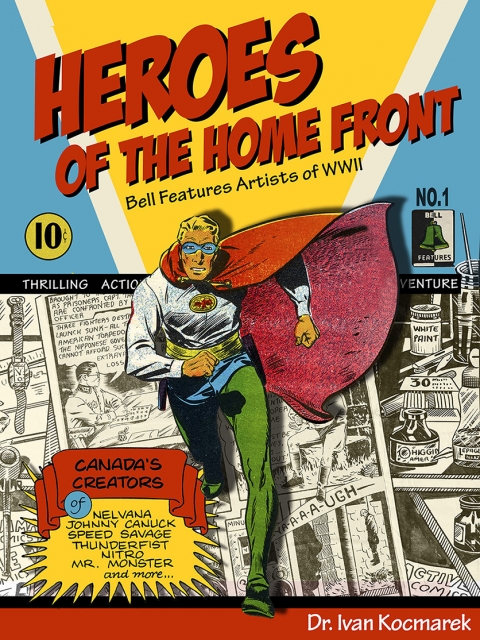
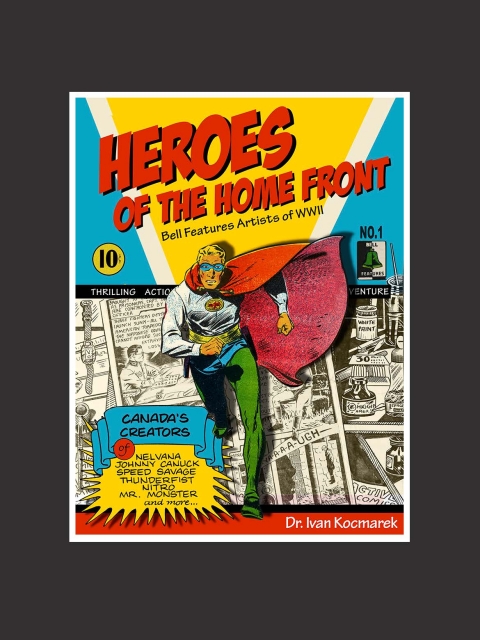
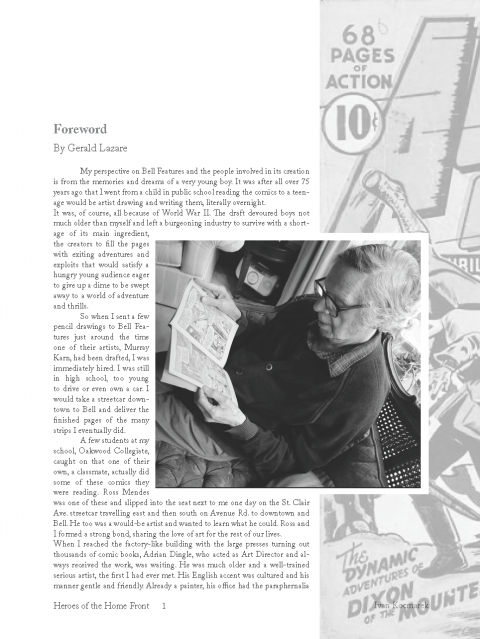
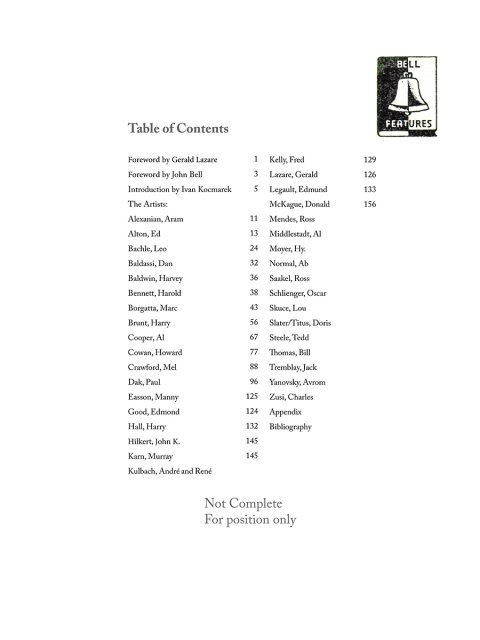
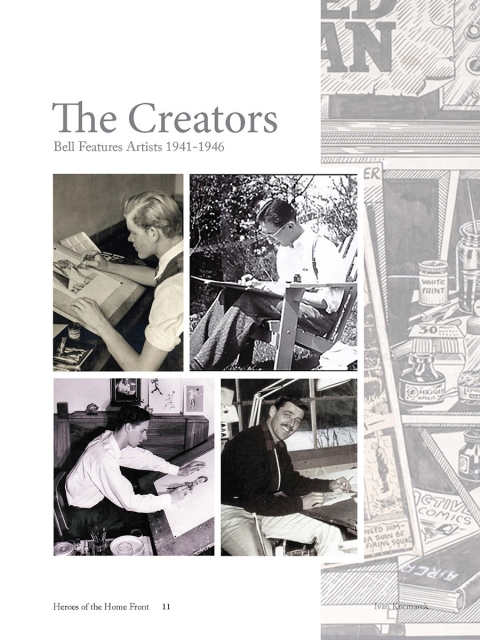
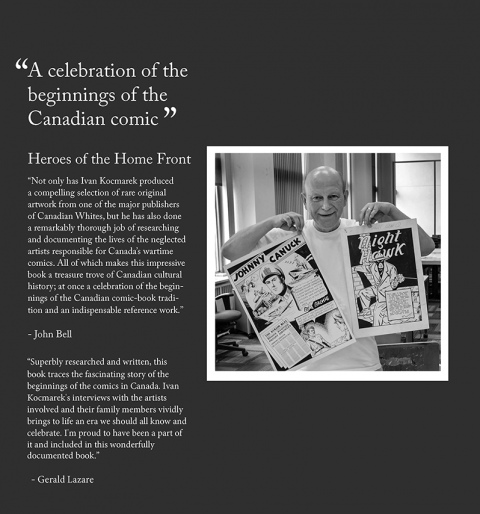
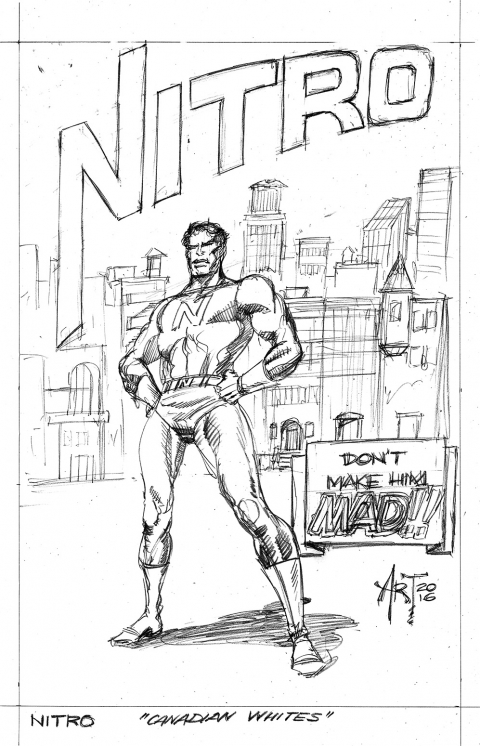
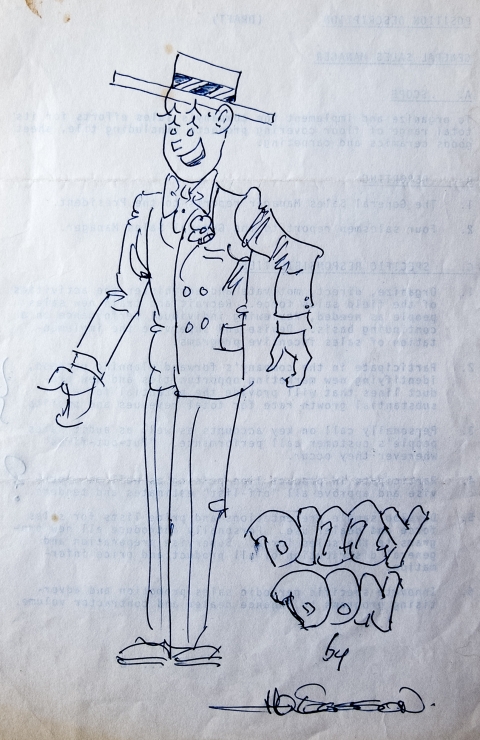
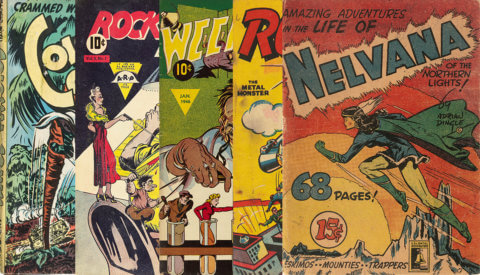
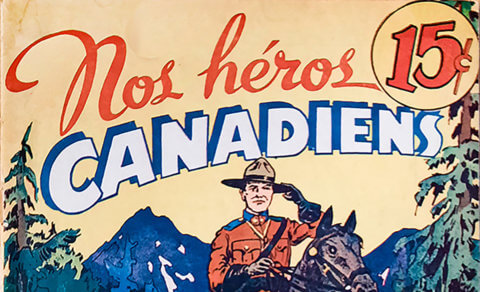
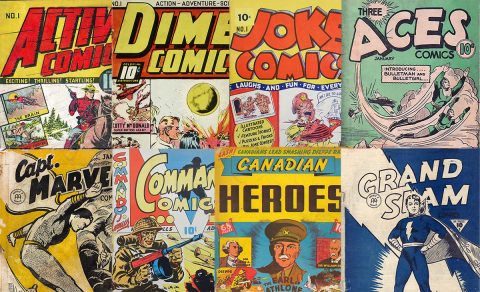
Ivan
I’ve always thought you were the best man for this job and it looks like you have most of the bases covered. The great thing about a book such as yours is that, now that these comics have begun to reach a broader market and slabbing will undoubtedly be the fate of many of them, you now have a venue to bring the art itself to a wider audience and assure that it will always be in a format people can readily access, instead of locked away forever in some hoarder’s closet.
My first choice would be a nice hardcover, maybe even slip-cased like the Nelvana. I guess I can see why Chapterhouse would want to start with a softcover edition, but hardcore collectors, I feel, would not balk at a pricier format. We want this book to last!
Anyroad, with your dedication and knowledge, whatever format you settle upon, this will be a valuable addition to the history of the WECA books and should enjoy the same prestige and appreciation as Hirsch and Loubert’s groundbreaking contribution to the history of the medium.
cheers, mel
Thanks for your thoughtful comment, Mel. I also feel that completing the project with a large number of soft cover copies would result in the dilution of the whole enterprise. I began this project of an archaeology into these old Canadian comics and the people behind them because I had a tremendous interest and eventual pride in them and also because so little was known about them. I knew that there were a number of like-minded souls who would appreciate knowing more about them. I also wanted to know more about the individuals behind these books. So much was known about the creators behind American comics those from our fist age of comics were essentially anonymous. Then when I began getting in touch with the family members of these old artists I could see that they wanted the stories of their relative shared. The best way to satisfy my own passion for these books and the similar passion in others who have an high regard for these comics, as well as the impulse in the family members who want to have their creator relative remembered, was to put out a quality hard cover first and then allow for any secondary offshoots to evolve, if any. I am proud of these first Canadian comics and I want to share that pride properly.
Ivan, First, I am going to assume Chapterhouse has some experience with Kickstarter promotion. I would NOT recommend that you tackle it yourself…I think it can be a learning process, so I advise you get the benefit of experience. It’s like selling your family home by yourself or thru an agent… The agent gets a piece, but he can more than pay for himself with his experience.
I think the key is talk Chapterhouse into doing ALL three editions guaranteed in the Kickstarter program. Even if you or funders have to help make that happen. The best way to raise the most money is to offer it ALL at once, get the benefit of people “moving up” to better editions or at least buying in to the least expensive one. Don’t limit yourself with just one expensive edition.
You don’t get two chances at this. I think you can appeal to the widest possible audience with a SC, a HC (with some extra features), and a deluxe signed edition (in a slipcase). Perhaps even a couple deluxe variants, like your artist-signed one you mention and another, to make more copies available. 50 or 100 is a very, very small editon and will likely sell out too quickly, missing out on potential sales.
Skipping the DJ is fine, I lso don’t think people care and you are 100% right about potential for DJ damage. The slipcase is a nice feature and I’d try and make it available on some of the HCs if possible, it would reduce the per-unit cost to do more and would nicely protect even the regular HC edition (see PS Artbooks, they do this on every book for an extra $10).
I think you have a good project with a good chance for success and I think Kickstarter is a natural way to go. Make the stretch goals extras goodies that go with each edition, prints or whatever you come up with. Social media is VERY important, which is since you aren’t experienced in it, get onboard with someone who is. Facebook, Twitter, etc. Kickstarter is ALL about social media, and also making a video (see what Jim V did, below), and getting the word out to as wide a circle as possible.
I don’t understand the idea of library’s taking softcovers…my experience is that libraries prefer hardcovers, but maybe that is old school. McFarland has the library market down pat and that is something that may not tie in to Kickstarter at all…if not from Chapterhouse, find someone who knows the Canadian (if not also the U.S.) library market and how to reach it. I wish I could help more, but it’s not my field. Again, maybe a kind soul at McFarland (we can give you contacts) or Writer’s Digest/Northlight Books can help on reaching libraries.
They probably won’t buy into Kickstarter, at least in my uninformed opinion. They need billing and such, and may need a final product to create a purchase order. But if you get some commitments you can simply overrun enough copies to get them out there. You might even find a distributor who works with libraries to handle it for you. Maybe McFarland would buy into a portion of the run that could be imprinted especially for them.
My old partner Jim Vadeconcoeur used Kickstarter to fund the last issue, #13, of Images Magazine, and if it’s still up there somewhere, you can take a look at a good (and successful) first effort. But there are undoubtedly lots of great examples. Holly and Rachel have done well, it seems. Flesk Publishing (John Fleskes) is also a very good one to look at (and maybe get a printer recommendation–I think most/all of his stuff is done overseas). He’s young and smart and very successful with projects involving Brom, Mark Schultz, Wendy Pini, etc.
Let me know how I can help. As a retailer, we have often bought into Kickstarter programs, which helps the funding goal immediately. I would be glad to do this with your project if it gets my customers extras and stretch goals and, hopefully, some limited editions on top of SC and HCs.
Thanks Bud… lots of great suggestions and a lot to think about! I’ll take a look at some of those Kickstarter projects you mention and please do send along any of those contacts they might yield some very good advice and further contacts.
Hi Ivan,
A project like yours deserves the best fruit of your labors. If you have worked so dilligently for over 5 years in researching, your project should in fairness succeed. You certainly have my hopes for your success. But, in the real world, your efforts can only succeed if the end product is good!
Will your product be worthwhile to read? There are thousands of great comic books that noone has time in 2017 to read. There are so many cable cannels and internet you-tube videos and blogs to follow. Do people really care about Canadian kids books from 2 generations ago?
I do not think the ability to reread old comic book stories in your book is enough. People can read comics for free on microfich, or sent $9.50 USD for a fascimile copy of many Canadian and early US comics or DVD, through ebay. What you really need is a well written book on the readability scale of Mark Twain or Margaret Atwood or Orsen Wells.
My concerns are that you place a grusome hanging panal on the cover, offensive Japanese stereotype on cover, an imaginary Ab Nornal as artist in index, (surely a psudoname) and I feel the WECA acroname is alienating. WECA is about embargo for political WW2 reasons. On its face, WECA is an explantion for a shody product, drawn by teenage aspiring artists, with lack of color, quality control concerns, and a product which ultimately could not compete when put up against American Comics.
You will need exceptional writing skills to keep your readers interest. You should think of selling yourself with exceptional personal writing skills, not expect Whites alone to hold peoples interest. Your enthusiasm for Whites must be apparant and captivating. Nothing less will succeed! Whites alone can not stand alone because with the passage of changing values, have lost much of their relevance. We no longer hang people, we no longer hate Japs, we no longer think ab normal as cool, and few of us buy into WECA, meat rationing, or food coupons due to war shortages, as at all relevant. Your book must make it relevant again, thought writing and editorializing on par with Shakesphere.
If you book is not eligable for a Canadian goverment grant through your MP, i do not know what would be. Perhaps it would be eazier to make your book into a movie via grant by National Film Board.
With the internet, i think most people would be satisfied with posts and blogs of uploading online web information. You are doing the 1941 thing of making a paper bound book, which is a fitting historical expression on ink and paper of historic Canadian kids literature.
Lets hope your book is so well written and entertaining, it bring people back to Whites and rekindels interest in reading books in general.
Stevie V.
Thanks for your honest comments Steve. However, I must say that there do seem to be enough people who are interested in these comics to fund reprints of the runs of Nelvana, Johnny Canuck, and Brok Windsor in three separate hardback volumes. The Kickstarter should tell us if there are enough individuals interested in what I’ve done to warrant producing a book. Also, my book is not just reprinting those old Canadian comics. It contains over 150 full page reprints of the original artwork for the comics of the most popular publisher from the period and back stories on the artists who drew them. There are no comic book stories reprinted in my book.
The original artwork reproduced as background on the cover represents what the period was about (panel with the hanged figure is actually a fake hanging that the hero, Red Thortan, has staged so that he can escape the Japanese prison he is in). Steve, I also think that you’ve jumped into a disparaging stereotype of these books because you maybe not familiar with enough of them. One of the aims of my book is to break this stereotype. Remember that the American production and market was ten times that of Canada’s so that there was a greater number of really great artists and an equally great number of weaker hacks as well. A lot of Canadian war time art is really worth looking at… ask Bud Plant who has seen lots of both. There were only a handful of artists in their teens who worked for Bell Features. Bell had a few well established editorial cartoonists who were in their forties such as Hy Moyer, Harry S. Hall, and Lou Skuce. Others in their thirties such as Oscar Schlienger, the Kulbach twins, Avrom Yanovsky, Edmond Good, Al Middlestadt, and Adrian Dingle came with proper art training and were professional artists already when they began working for Bell. The largest number of artists at Bell were in their mid twenties.
“Ab Normal” is a pseudonym I haven’t been able to crack, so that’s all I’ve got.
In the end, I don’t think we’ve really come that far from the 40s and the time of the Second World War… look who’s president south of the border.
Well, Ivan, it looks like you have to have the literary licks of Atwood, Twain and Shakespeare to pull this off, but I firmly believe there are enough people interested in this period for a book like yours and, as I said above, you’re the best man for the job.
Mel, like Bukowski said “what matters most is how well you walk through the fire….”
Ivan, I think the (hopefully) large audience you have built up with all your columns should really benefit your kickstarter program.
Having not seen and read as many WECA stories as you and others, I have to admit some of my favorite material is Anglo’s final run of full color work with Freelance Robin Hood and Grand Slam/Three Aces. Its just fun, the art is quite good, and it benefits from full color.
I would like to see Hope, Rachael or someone collect this work. It also benefits since it looks so much like beloved Fawcett comics in style, making it more accessible to U.S. fans of Fawcett heroes like Capt. Marvel and family, and the Golden Age in general.
I wonder if PS Artbooks would take a stab at it if someone else doesn’t step up. Do you know if anyone is considering this? I would rather see it come from your country…PS books are very pricey ($60) and lately have less extras like the informative intros the used to include. But I still sell them, quantities of every title that keeps comics out.
Regarding Steve’s suggestions: Steve, I think you bring up some valid points. There is a lot of WECA material that is sub-par, more in the style of early U.S. fanzine amateur strips in the early 1960s. But there is still some fine material, and much interesting work, even if a bit weaker, when taken in the proper perspective of the time when it was produced.
A lot of early U.S. Golden Age work (1938-1945, say) has the same problems, but taken as part of a greater story, I still find it worth study. But it doesn’t all rise to deserving complete reprinting. Ivan is writing an overall history. Collecting individual comics and stories is the job of others, like Rachel, Hope, and perhaps some new players.
I have been a retailer (and wholesaler) of comic book reprints and of histories for longer than Just about anyone–all entirely in print form. But I I agree with you, it is an uphill battle to bring new readers into WECA material. The average fan needs something that hooks him…like Nelvana as the first superheroine and a product of native mythology. Or Brok Winsor, with good art and reasonable sci fi stories and new modern extras. A collection like Johnny Canuck falls down for me, with very weak art and story both. One-shots like the recent Dime Comics/Polka Dot Pirate and Wow Comics have very limited appeal without more context to support them.
But…there is still a market for the right print material. The age of online snippets and ebooks has not taken over yet. The predictions of the end of the print market have been very premature. A wide swath of humanity still wants to hold this material in their hand…and also to get one complete, well told story between two covers, with a beginning, middle and end. That is what Ivan is offering. You can’t get that from trolling internet mentions and snippets and images in a non-linear fashion.
Thanks again for your helpful comments, Bud and even more thanks for trying to champion my effort south of the border.
Once we get a solid monetary goal for the Kickstarter by refining our budget as much as we can, I too hope there are to make a go of it. I don’t want to make any money on this. I just don’t want to lose any and I honestly think there are enough interested people to make this happen, especially if kickstarters for Nelvana, Johnny Canuck, and Brok Windsor worked out so well.
I know that Chapterhouse is planning to reprint the whole run of Freelance books in the next year or so. An idea of all the colour Anglos assembled together in one volume would be a great sell, I think.
I agree with you about Johnny Canuck and I’ve never understood why he has become a Canadian golden age icon. He was never featured on a WECA comic cover (even Ed Alton’s Doodlebugs got two) and the writing and artwork have never impressed me. I think it’s mainly because he has the name of our national archetypical figurehead like your Uncle Sam and England’s John Bull. This has carried him a long way but I don’t think he ever had anywhere near the popularity that Freelance had during the 40s.
When you read John Bell’s Foreword to the book you can see how important getting the stories of these individual creators out is in order to understand what Canadian comics are all about eve those produced today and how this fits into the development of Canadian pop culture and Canadian identity itself after all.
Thanks again for all your support, Bud.
I’ve been reading your column for quite awhile. Your knowledge of the “Whites” is quite expansive. If anyone should author a book about that era it is you. While I agree with some of the comments that there was a lot of bad artwork, I think it depends on how you present it. You acknowledge the bad but hi-lite the creativity.There were also a lot of bad American comics but with a bigger talent pool those comics tended to fall by the wayside.
The Nelvana and Brok books show there is a market and interest. A collected Freelance book would be interesting or even Commander Steel, since he also had some stories in colour.
As with your profile of Aram Alexanian where you showcased the original art versus the re-drawn art that could be another aspect to hi-lite.
However this book is published I look forward to buying it and reading it.
p.s. I done my own take on Canadian Whites. Check me out on deviant art
user name: SpeedSavage. I would appreciate ant commnets from you.
Peter, thanks for your comments and your ongoing interest in my column. The graphics in the book will be 95% original art pages with some published covers and pages used where there was no original art available as is the case with Jack Tremblay, for example.
Your SpeedSavage posts on Deviantart are well worked takes on how more recent versions of these old war time Canadian heroes might have been presented. It’s a great exercise in the imagination to think of what would have become of The Penguin after Dingle transformed him into The Blue Raven in Slam-Bang 7 for example or what a title like Unusual Comics which was meant to be populated with Bell Superheroes like The Dreamer and Polka-Dot Pirate would have looked like. Your posts there have done some of this and done it well. I hope other readers of this column will take a look.
Ivan, Greetings from New Zealand – from an ex-pat Canadian (just to be clear). Regarding publishing, a mate here has published a number of high quality hardback travel books through a US company, Blurb. As publisher, he has complete control of all aspects of the book – pictures, language, format, etc. I know you’d prefer a publisher to publish but necessity is the mother of invention. Please put me down for a copy of Heroes of the Home Front. I too would prefer a hardback version. Cheers. Mike PS I do have that bunch of well-read Anglo-American comics if you ever find an interested party.
Thanks for your comment, Mike. It’s really great to hear from somebody (especially an ex-pat) who’s a couple of continents away. I’ll look into the Blurb company. Will keep you updated on the book.
Good luck with the book.
I’ve been indexing scans from the Bell Features collection at the Library and Archives Canada for the Grand Comics Database, so I’ve read a lot of these books and whenever I had trouble figuring out a partial name, or a set of initials, or just wanted some more general information, I would look at your site. A lot of good information.
Good to know some of the creators are still around.
Thanks for the comment, KAM. I’m glad to hear that more research work is being brought to bear on these old Canadian comics and that comics.org is finally catching up to them. Don’t hesitate to ask any questions if I can be of help.
Ivan, I can’t tell you how excited I am about this book! Despite the recent spate of reprint projects undertaken by Hope Nicholson and by Rachel Richey, I feel the thirst for more information on these early Canadian comics and their creators is still strong. I love and collect original art myself and it’s great you can include so much here. I would love a hardcover version of the book and think that most people will expect this. The material demands this and and it would be a fitting tribute to the men and women the book is dedicated to. Your potential audience will take the book more seriously as an art book as well if a hardcover.
As for the proposed design, I like the brash comic book-style cover but not the awkward mix of hand-lettered look and more “formal” computer font for the subtitle and author name. I see this quite a bit and it always feels at best a compromise that says, we don’t trust the audience or subject matter enough to fully commit to the comic book style and want to show this isn’t actually a comic book and at worst like the designer doesn’t know what he is doing or is unfamiliar with comics. Also awkward to list artists by surname on the contents page. Looks too much like an index or academic book for what I assume is meant to be a more populist history.
I’m also not a big fan of cluttering up these kinds of books with fan art, pin-ups and too many forewords and afterwords. I feel like it waters-down the core material too much, but that’s probably just me.
Besides a strong start, luck, and an intriguing product, Kickstarters are driven almost entirely by a strong social media and the bigger and more engaging your social media presence is even before the fundraising begins, the better. I can’t help you there since I’m essentially a social media failure, but these are things I’ve observed.
Anyway, great project! I look forward to more updates.
ivan, despite being along time comic collector, I had no real interest in The Canadian whites/Bell books. The journey you’ve taken me on in this forum has drawn me in . I had a similar journey with DC’s big five War books in the early “90’s. CHRIS PEDRIN’S BIG FIVE INFORMATION GUIDE #1 introduced me and many others to War comics and perhaps you will \ can have similar success.
Make it good Ivan and Best of Luck.
Let me know where I can make a pre-order that would best assist your cost margins.
I suggest that books such as Pedrins, Gerbers, and now I expect yours, have given me more joy in comic collecting then any other influence.
Bryan, thanks for the supportive comment and for the suggestions you made concerning the cover fonts, hardcover vs. softcover and your other personal preferences for the style of the book. I’ll take all these into account but it remains to be seen what operative factors we’ll encounter in our effort to bring the book out. As for the social networking presence that a Kickstarter campaign demands, that’s where Chapterhouse could really pull it’s weight. Thanks again for your support.
Dave, I’m glad we’ve made another convert to these great old Canadian comics. I’ll certainly make an announcement about the Kickstarter launch in these pages but the best thing would be to send me an email so I can put you on my contacts list for information about the book and notify you that way when things happen. If you click on any of the icons next to my name in my replies you’ll get my email.
Is my dad’s work gonna make it into the book?
Ross Hillenbrand
Sorry Ross, this book is only on the artists that worked for the Toronto-based Bell Features publishing company. Artist from the other publishing companies including Educational Projects in Montreal, which is the company your dad worked for, will have to be covered in a separate volume. The Toronto material was the easiest to access and find, so that is the first covered.